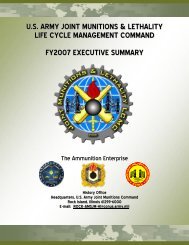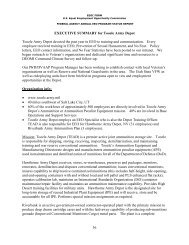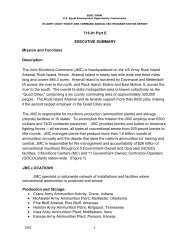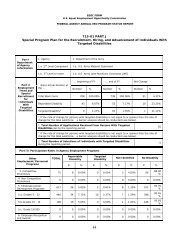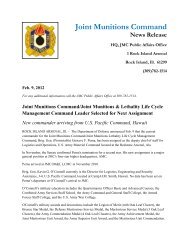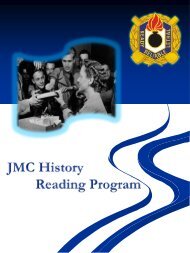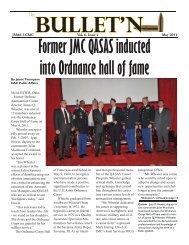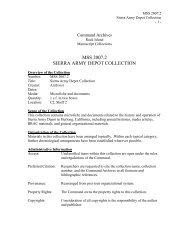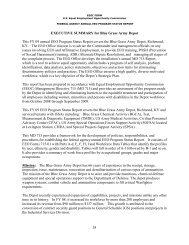History of the Ammunition Industrial Base - JMC - U.S. Army
History of the Ammunition Industrial Base - JMC - U.S. Army
History of the Ammunition Industrial Base - JMC - U.S. Army
You also want an ePaper? Increase the reach of your titles
YUMPU automatically turns print PDFs into web optimized ePapers that Google loves.
<strong>Ammunition</strong> O<strong>the</strong>r than Heavy Field<br />
Bombs<br />
Heavy Field Artillery<br />
1942 1943 1944 1945<br />
The requirements and inventory reporting processes had been so inefficient that in<br />
September 1945, <strong>the</strong> <strong>Army</strong> was adrift in excess ammunition <strong>of</strong> all types. In particular, last<br />
minute surges in artillery ammunition production provided a significant excess <strong>of</strong> those rounds.<br />
In addition, due to <strong>the</strong> sudden shut down from full volume production, significant amount <strong>of</strong> inprogress<br />
materiel was on hand and assumed by <strong>the</strong> <strong>Army</strong>. Thus, <strong>the</strong> <strong>Army</strong> owned components <strong>of</strong><br />
ammunition rounds in addition to complete rounds. To add to issues, <strong>the</strong> <strong>Army</strong> began to<br />
retrograde ammunition from overseas <strong>the</strong>aters or destroyed it in place through detonation, burial<br />
or dumping in open water. While <strong>the</strong> <strong>Army</strong> knew it had a large stockpile <strong>of</strong> ammunition, by <strong>the</strong><br />
time <strong>the</strong> Korean Conflict started, <strong>the</strong>y were just ending an initial inventory process. This made<br />
forecast and planning efforts difficult in <strong>the</strong> beginning <strong>of</strong> <strong>the</strong> Korean Conflict mobilization.<br />
Despite not knowing <strong>the</strong> full extent <strong>of</strong> <strong>the</strong> post-WWII stockpile, <strong>the</strong> Services determined<br />
sufficient ammunition existed and <strong>the</strong> next war could be fought using <strong>the</strong> excess stored in <strong>the</strong><br />
vast depot system. Unfortunately, this plan did not take into account <strong>the</strong> modernization process<br />
or <strong>the</strong> relative technological state <strong>of</strong> <strong>the</strong> excess ammunition. Also, <strong>the</strong> plan did not consider <strong>the</strong><br />
potential problems if <strong>the</strong> next war was long or if <strong>the</strong>re were sustained increases in consumption<br />
rates. Finally, because <strong>of</strong> <strong>the</strong> reduction in funding, maintenance and inspections did not occur.<br />
Far more <strong>of</strong> <strong>the</strong> stocks were unserviceable in June 1950 than had ever been expected. 53<br />
Most ammunition built in WWII supported weapons systems designed in 1940 or 1941.<br />
There were some improvements items like <strong>the</strong> upgraded tank gun or rocket propelled charges,<br />
but even those upgrades were designed to defeat weapons in use in 1941. By <strong>the</strong> Korean<br />
53 William R. Reeder, “The Korean <strong>Ammunition</strong> Shortage,” unpublished, 1-5. (See all <strong>of</strong> Reeder for a strong<br />
summary <strong>of</strong> ammunition planning and production in Korea. Reeder was in DA at <strong>the</strong> time and prepared <strong>the</strong><br />
monograph as a case study for <strong>the</strong> <strong>Army</strong> Comptrollers Course at Syracuse University.); James A. Huston. The<br />
Sinews <strong>of</strong> War, <strong>Army</strong> Logistics 1775-1953 (Center for Military <strong>History</strong>, Washington D.C.: 1966): 630-634.<br />
19



